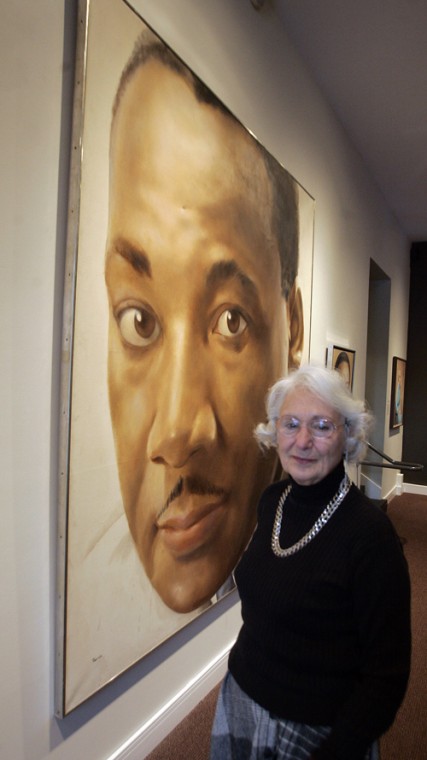Artist had intimate view of civil rights movement
Leonore Templeton poses with a portrait of the Rev. Martin Luther King, Jr. at the Mattatuck Museum in Waterbury, Conn., Thursday, Jan. 15, 2009. Bob Child, The Associated Press
January 22, 2009
WATERBURY, Conn. – Rosa Parks was an icon of the civil rights movement, but she didn’t think she was important enough to have her portrait painted by artist Robert Templeton.
Parks, who helped spark the civil rights movement after she refused to give up her seat on a bus to a white man in 1955, was baffled that Templeton had flown all the way from New York to Detroit in 1970. Parks, who died in 2005 at age 92, figured he was just trying to use her to gain access to the congressman for whom she worked at the time.
“He was really amazed,” said Leonore Templeton, his widow. “She kept doubting that he actually came to paint her portrait. She was such an unassuming lady.”
Robert Templeton, who died in 1991 at age 62, spent years painting portraits of civil rights leaders, including an 8-foot oil painting of the Rev. Martin Luther King Jr. His collection is on display at Mattatuck Museum Arts and History Center in Waterbury through March 22 in an exhibit called “Lest We Forget: Images of the Civil Rights Movement.”
“They’re compelling works because the large scale and the close-up view gives us a real sense of the character and the personality of the leaders of the movement,” said curator Cynthia Roznoy. “He had a good insight into personality and was able to express that through his brush.”
Get The Daily Illini in your inbox!
Templeton’s project, first shown at Emory University in Atlanta in 1986, gave him an insider’s view of the turbulent times and those who shaped them. His family is hoping to find a permanent home for the collection.
“He hoped with his paintings he would move people who walked though the collection to have a change of heart if they were in any way racist, that they could see these people in all their dignity, all their determination,” Leonore Templeton said.
Robert Templeton was born the year of the stock market crash in 1929, and his father eventually lost the family farm in Iowa.
“He really grew up experiencing poverty,” Leonore Templeton said. “I think naturally he had sympathy for the underdog from his own experience.”
Templeton was doing portraits in Detroit when riots broke out in 1967. He drew sketches that wound up on the cover of Time magazine and are on display at the museum, but it was a dangerous assignment as rioters set fires and gun shots filled the air.
“They were throwing bricks at my husband, too,” Lenore Templeton said, recalling that a man reached into his car window and tried to strangle him.
Templeton had seen segregation up close earlier in Atlanta, where he witnessed sit-ins at lunch counters. Moved by what he saw in the South and in Detroit, he began his portrait project so that civil rights leaders would be recognized and remembered.
“He said he was sure someday they would succeed and this injustice would end,” Lenore Templeton said.
Benjamin Mays, president of Morehouse College, helped open doors for the white painter.
Civil rights leader A. Philip Randolph, president of the Brotherhood of Sleeping Car Porters, was near death, but got out of bed for his portrait. The frail, elderly man told Templeton how the FBI once viewed him as the most dangerous man in America because he had the power to bring the country to a standstill.
“When he said that to my husband, he had a real twinkle in his eye,” Lenore Templeton recalled.
Templeton also painted the Rev. Ralph David Abernathy, a close aide to the Rev. Martin Luther King Jr., but didn’t get to paint King before he was assassinated in 1968. His widow, Coretta Scott King, helped him sort through photos for the portrait.
“The expression in the photo is a combination of determination, sadness, resignation, hope,” Lenore Templeton said. “I think it touched a fear – he must have known someone would eventually assassinate him.”
Templeton also did artist renderings for the trial in 1971 of Black Panthers founder Bobby Seale in New Haven. When he tried to do a sketch on a napkin, the judge who had banned photographers and sketching materials threatened to send him to jail, his son Kevin said.
And Templeton painted a portrait of President Jimmy Carter that is displayed in the Hall of Presidents at the Smithsonian’s National Portrait Gallery in Washington.
Lenore Templeton said she went to the White House to help her husband set up for Carter’s portrait. The bulletproof windows didn’t let in a lot of light, so Templeton told his wife to tape back the draperies.
“I have the distinction of setting off the alarm in the Oval Office,” Templeton said.
Secret Service agents came in with guns drawn and told the couple not to move. “Then they said, ‘Don’t touch the curtains,'” she said.
Carter arrived later, talking to Templeton about her native Germany as he prepared for a trip to the country. Carter and Robert Templeton talked about their childhoods working on farms that played crucial roles in both men’s lives.







